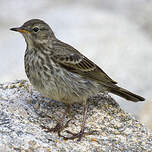European Rock Pipit
Anthus petrosus - Pipit maritime
Identification
The plumage of the European Rock Pipit is remarkably mimetic on the seaweed, the predominant vegetation on the bird's biotope: Its brown colors are tinged with olive green, on its back and wings as well as on the dense streaks of its breast. Its beige is less pale than in other pipits, including the Meadow Pipit, to which the European Rock Pipit was for a long time considered as a subspecies. The well-visible eye ring, as well as the light areas of the supercilium, the outer rectrices, and the alar bars are common features with the Meadow Pipit. However, these areas are lighter in the latter in winter, the only period during which the two species can be found together on the coast.
Subspecific information 2 subspecies
- Anthus petrosus petrosus (British Isles and w France)
- Anthus petrosus littoralis (Scandinavia to nw Russia)
Foreign names
- Pipit maritime,
- Bisbita costero,
- petinha-marítima,
- Strandpieper,
- parti pityer,
- Oeverpieper,
- Spioncello marino,
- skärpiplärka,
- Skjærpiplerke,
- ľabtuška skalná,
- linduška skalní,
- Skærpiber,
- luotokirvinen,
- grasset de costa,
- Strandtittlingur,
- świergotek nadmorski,
- akmeņu čipste,
- obalna vriskarica,
- Береговой конёк,
- ニシヨーロッパタヒバリ,
- 石鹨,
- skärpiplärka,
- 岩鷚,
Voice song and call
The call of the European Rock Pipit is close to that of its cousins: a less often repeated metallic psiit than that of the Meadow Pipit at take-off. Like the latter, the song of the European Rock Pipit is emitted during the slow descent phase parachuting of the nuptial flight.
Habitat
Behaviour character trait
Dietfeeding habits
Reproduction nesting
The European Rock Pipit builds a cup of vegetation (grass, algae...) filled with fine materials, usually in a rock hollow, under a slope or a tuft of grass in the coast meadow. Generally the female lays 4-5 eggs there, incubated for two weeks. The flight of the young is triggered after two more weeks.
Geographic range
The European Rock Pipit can be seen from the coasts of North Africa to the far north of Scandinavia. The most southerly range (up North of Aquitaine) is only used for wintering while the Northernmost region (Scandinavia) is used only for breeding. Breton and Vendéen coasts are home to both nesting European Rock Pipits and wintering ones. The species is only present in the Mediterranean Sea in the Gulf of Lion.
Threats - protection
IUCN conservation status
concern
in the Wild
threatened
evaluated
Sources of information
- IOC World Bird List (v15.1), Gill, F and D Donsker (Eds). 2025-12-07.
- Encyclopédie des oiseaux de France (fiches), Collectif - Rédaction NICOLLE Serge
- Les Oiseaux d'Europe, d'Afrique du Nord et du Moyen-Orient, Lars Jonsson
- Les passereaux d'Europe, tome 1, P. Géroudet, M. Cuisin
Other sources of interest
 Specification sheet created on
02/08/2023 by Renan Levaillant
Specification sheet created on
02/08/2023 by Renan LevaillantTranslation by AI Oiseaux.net
© 1996-2025 Oiseaux.net
- Accipitriformes
- Aegotheliformes
- Anseriformes
- Apodiformes
- Apterygiformes
- Bucerotiformes
- Caprimulgiformes
- Cariamiformes
- Casuariiformes
- Charadriiformes
- Ciconiiformes
- Coliiformes
- Columbiformes
- Coraciiformes
- Cuculiformes
- Eurypygiformes
- Falconiformes
- Galliformes
- Gaviiformes
- Gruiformes
- Leptosomiformes
- Mesitornithiformes
- Musophagiformes
- Nyctibiiformes
- Opisthocomiformes
- Otidiformes
- Passeriformes
- Pelecaniformes
- Phaethontiformes
- Phoenicopteriformes
- Piciformes
- Podargiformes
- Podicipediformes
- Procellariiformes
- Psittaciformes
- Pterocliformes
- Rheiformes
- Sphenisciformes
- Steatornithiformes
- Strigiformes
- Struthioniformes
- Suliformes
- Tinamiformes
- Trogoniformes




























